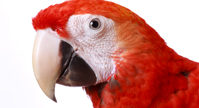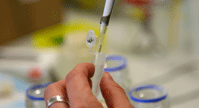Chlamydiosis, Chlamydia psittaci, Psittacosis
Animal Genetics offers PCR and ELISA testing for Chlamydia Psittaci, an intercellular gram-negative bacteria that can cause disease in birds and mammals, including humans.
Description:
 Chlamydia psittaci is the bacterial species that causes the disease referred to as psittacosis, Parrot Fever or chlamydiosis. The word psittacosis comes from the Greek word 'psittakos', meaning parrot. Chlamydia are gram-negative, spherical (0.4-0.6 micron in diameter), intracellular parasites that are sometimes referred to as "energy parasites" because they use ATP (a crucial energy-containing metabolite) produced by the host cell.
Chlamydia psittaci is the bacterial species that causes the disease referred to as psittacosis, Parrot Fever or chlamydiosis. The word psittacosis comes from the Greek word 'psittakos', meaning parrot. Chlamydia are gram-negative, spherical (0.4-0.6 micron in diameter), intracellular parasites that are sometimes referred to as "energy parasites" because they use ATP (a crucial energy-containing metabolite) produced by the host cell.
Incubation periods in caged birds vary from days to weeks and longer. Most commonly this period is approximately 3 to 10 days. Latent infections are common and active disease may occur several years after exposure.
In birds, C. psittaci may manifest itself as an upper respiratory infection with nasal and/or ocular discharge, diarrhea, or a combination of all three. In some cases, birds may be infected but show no signs. These cases are of concern because these birds may become carriers and shed the organism.
A major concern with C. psittaci is the zoonotic potential of the organism. A zoonotic disease is an infection which can be transmitted from animals to humans. C. psittaci is also one of the major causes of infectious abortion in sheep and cattle.
Note: C. psittaci is related to Chlamydia trachomatis (the most common human STD) and Chlamydia pneumonia (a cause of human pneumonia). Chlamydia pneumonia is also being investigated as possibly being associated with cardiovascular disease in humans.
Transmission:
Transmission of C. psittaci from one host to another occurs primarily through the air. The bacteria is shed from an infected bird in the nasal and/or ocular secretions, fecal material and feather dust. The organism remains remarkably stable outside the host body and dries as a dusty substance. This dust or aerosol contaminates the air that is then inhaled by another possible host. Susceptibility as well as the amount of contamination determine whether or not the new host becomes infected with the disease. Vertical transmission through the egg has been shown in domesticated ducks.
The disease has a greater chance of spreading in overcrowded conditions, stale air environments, nest-boxes, and brooders. Pet shops, bird shows, and quarantine stations are also high risk areas.
Note: Transmission of C. psittaci from birds to humans has been confirmed in a number of cases. Although psittacosis infection in humans is rare, it is potentially dangerous for persons who are sick, elderly, immunosuppressed (e.g., HIV patients) or pregnant. These people should consult their doctor for more information concerning chlamydiosis.
Symptoms:
In young birds clinical signs can include rough plumage, low body temperature, tremor, lethargy, conjunctivitis, dyspnea, emaciation, sinusitis, yellow to greenish droppings or grayish watery droppings. Adult birds may develop symptoms such as tremors, lethargy, ruffled feathers, progressive weight loss, greenish diarrhea, occasional conjunctivitis, and high levels of urates in droppings. Birds that have chlamydiosis may develop one or several of these symptoms as the disease progresses.
Clinical changes associated with a chlamydiosis infection include a white blood cell count elevated 2-3 times the normal levels, HCT decreased 25-40%, SGOT elevated at least 2-3 times the normal levels, LDH elevated by at least 20% and AST elevated by at least 2-3 times the normal limit. Other more slight changes can occur in blood hematology and chemistry.
*Note: In humans, abrupt onset of fever, chills, headache, loss of appetite, shortness of breath, malaise, myalgia, and conjunctivitis can occur as a result of a chlamydiosis infection.
Prevention:
Preventing the organism from entering your facility is the best method of prevention. Test and quarantine all new birds before entering them in your aviary. Avoid bird shows and fairs where the disease can spread. Common sense hygiene includes the removal of fecal material and quality air circulation.
Sample Type:
When testing individual birds, cloacal and/or throat swab are required. If the sample tests positive, the bird should be placed in quarantine and treatment should begin immediately.
Postmortem swabs or samples of liver, spleen or kidney tissue in a sterile container may also be submitted for testing. Environmental testing using swabs of aviaries, counter tops, fans, air-filters, nest-boxes, etc. is extremely effective in determining the presence of C. psittaci in the environment.
Note: It is recommended to submit both a cloacal and/or a cloanal swab sample for analysis when possible.
Limitations:
As with any genetic test, new mutations may occur in the organism's genome that could affect the assay. Therefore, it may be difficult to detect all subtypes. Sample collection plays a pivotal part in the overall accuracy of the test, so please use caution and follow the instructions carefully.
Treatment:
Most treatments involve the use of Tetracycline and its derivatives such as Vibramycin, Doxycycline and Oxytetracycline. The antibiotic can be given by intravenous or intramuscular injections. Antibiotics can also be given orally or mixed with palatable food. Treatment periods generally last about 45 days, varying slightly depending on the treatment. Note: Calcium should be withheld because tetracycline binds to calcium. Citric acid in the bird's drinking water can increase the levels of antibiotics in the blood. Consult your verterinarian about specific treatment options.
Note: In humans, Tetracycline and its derivatives are generally an effective treatment for chlamydiosis.
Submit a Sample for Testing:
To submit a sample download a test submission form at Downloads
Cost per sample is $24.50. Please see our fee schedules below for bulk and combination rates.










